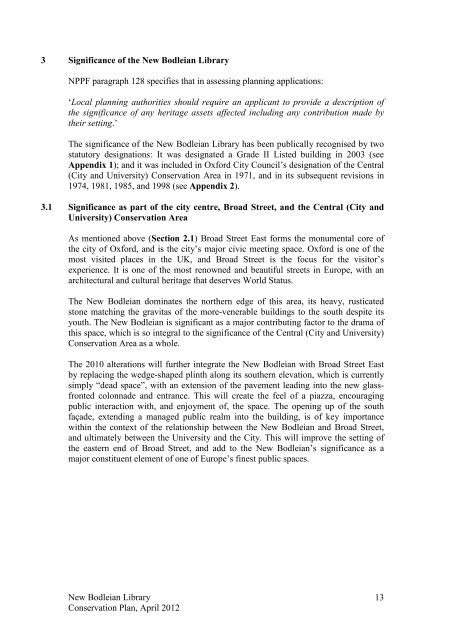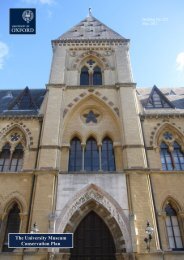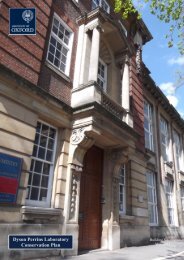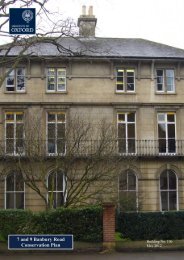The New Bodleian Library Conservation Plan - Central ...
The New Bodleian Library Conservation Plan - Central ...
The New Bodleian Library Conservation Plan - Central ...
- No tags were found...
You also want an ePaper? Increase the reach of your titles
YUMPU automatically turns print PDFs into web optimized ePapers that Google loves.
3 Significance of the <strong>New</strong> <strong>Bodleian</strong> <strong>Library</strong>NPPF paragraph 128 specifies that in assessing planning applications:‘Local planning authorities should require an applicant to provide a description ofthe significance of any heritage assets affected including any contribution made bytheir setting.’<strong>The</strong> significance of the <strong>New</strong> <strong>Bodleian</strong> <strong>Library</strong> has been publically recognised by twostatutory designations: It was designated a Grade II Listed building in 2003 (seeAppendix 1); and it was included in Oxford City Council’s designation of the <strong>Central</strong>(City and University) <strong>Conservation</strong> Area in 1971, and in its subsequent revisions in1974, 1981, 1985, and 1998 (see Appendix 2).3.1 Significance as part of the city centre, Broad Street, and the <strong>Central</strong> (City andUniversity) <strong>Conservation</strong> AreaAs mentioned above (Section 2.1) Broad Street East forms the monumental core ofthe city of Oxford, and is the city’s major civic meeting space. Oxford is one of themost visited places in the UK, and Broad Street is the focus for the visitor’sexperience. It is one of the most renowned and beautiful streets in Europe, with anarchitectural and cultural heritage that deserves World Status.<strong>The</strong> <strong>New</strong> <strong>Bodleian</strong> dominates the northern edge of this area, its heavy, rusticatedstone matching the gravitas of the more-venerable buildings to the south despite itsyouth. <strong>The</strong> <strong>New</strong> <strong>Bodleian</strong> is significant as a major contributing factor to the drama ofthis space, which is so integral to the significance of the <strong>Central</strong> (City and University)<strong>Conservation</strong> Area as a whole.<strong>The</strong> 2010 alterations will further integrate the <strong>New</strong> <strong>Bodleian</strong> with Broad Street Eastby replacing the wedge-shaped plinth along its southern elevation, which is currentlysimply “dead space”, with an extension of the pavement leading into the new glassfrontedcolonnade and entrance. This will create the feel of a piazza, encouragingpublic interaction with, and enjoyment of, the space. <strong>The</strong> opening up of the southfaçade, extending a managed public realm into the building, is of key importancewithin the context of the relationship between the <strong>New</strong> <strong>Bodleian</strong> and Broad Street,and ultimately between the University and the City. This will improve the setting ofthe eastern end of Broad Street, and add to the <strong>New</strong> <strong>Bodleian</strong>’s significance as amajor constituent element of one of Europe’s finest public spaces.<strong>New</strong> <strong>Bodleian</strong> <strong>Library</strong><strong>Conservation</strong> <strong>Plan</strong>, April 201213
















